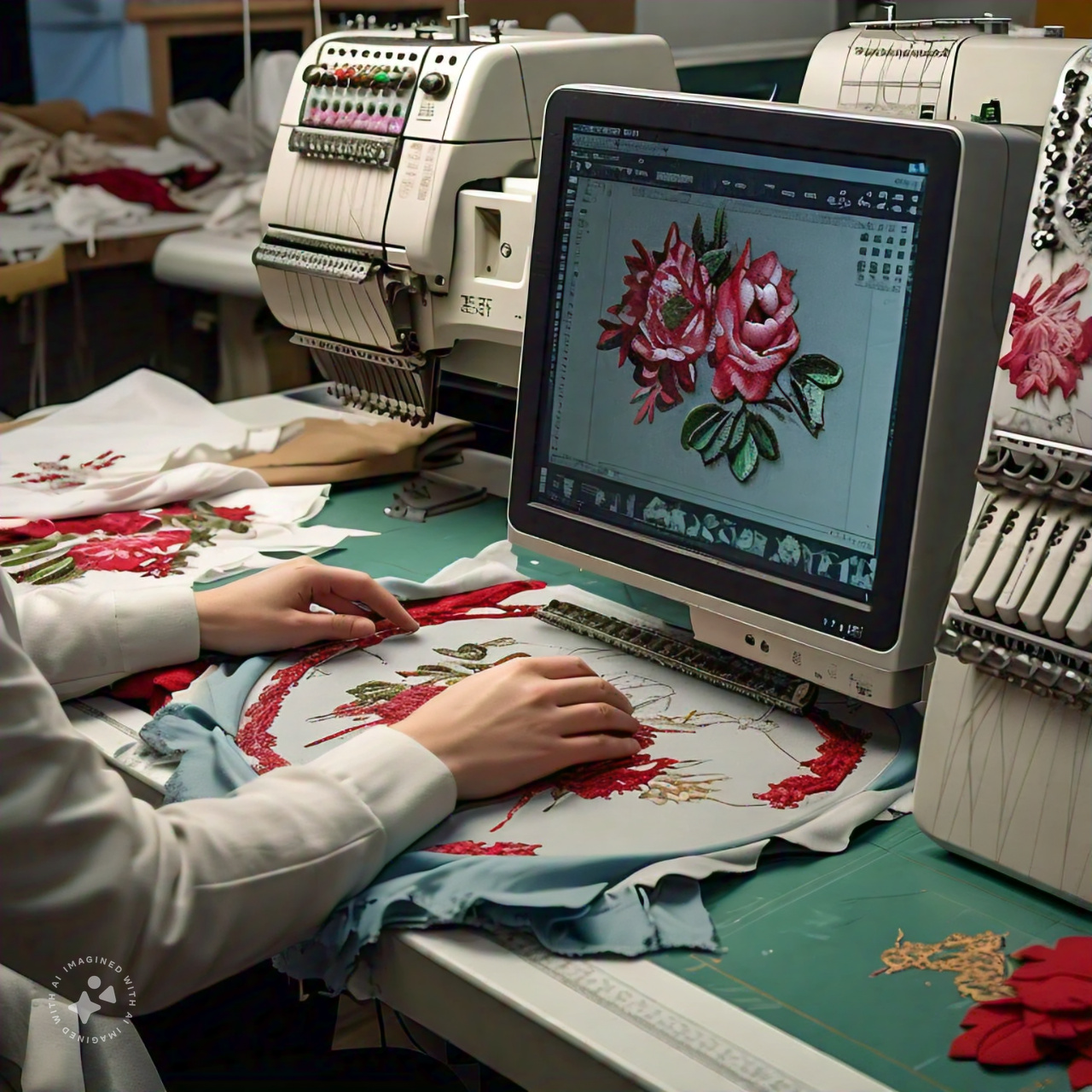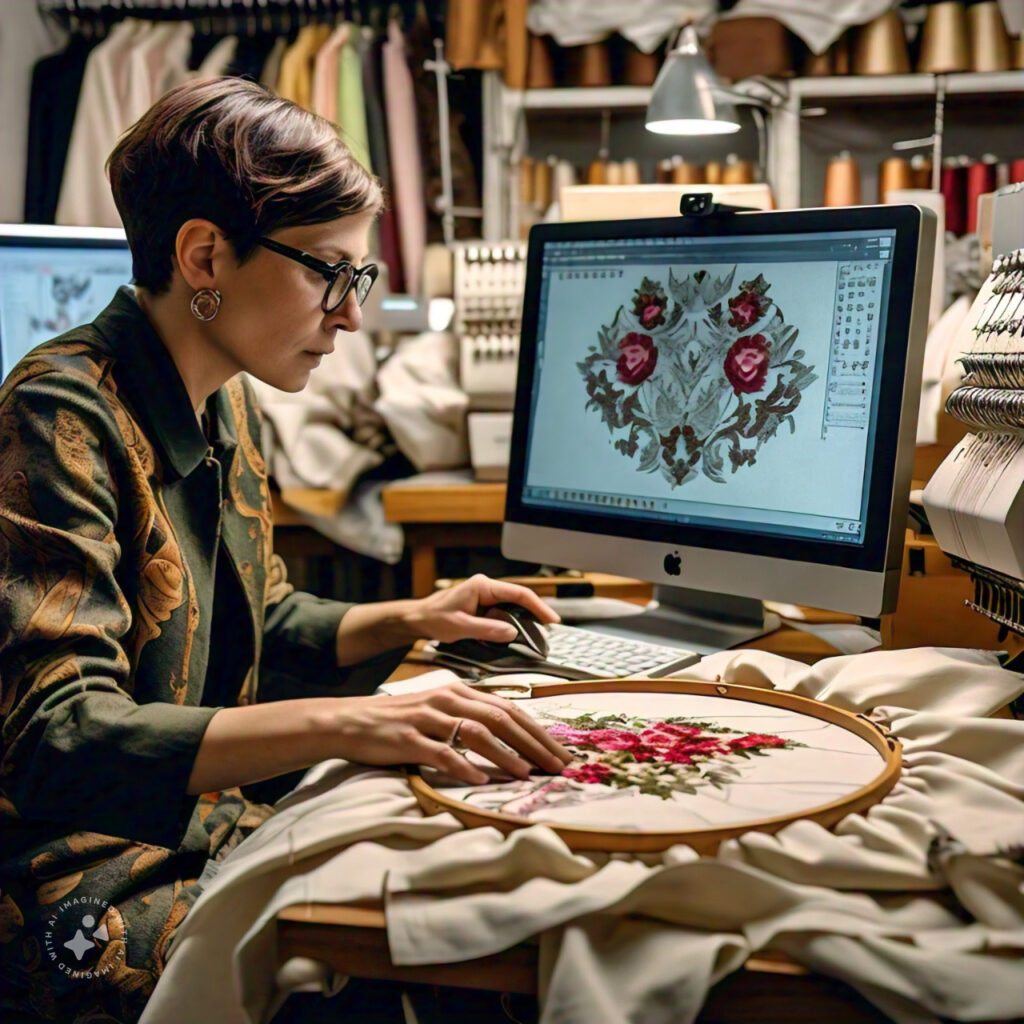Embroidery digitizing transforms designs into machine-readable files, ensuring high-quality, intricate embroidery for fashion brands. Discover why it’s essential for creating custom apparel and how collaborating with embroidery digitizing services can elevate your brand. Learn the benefits of precision, scalability, and the versatility of digitizing to the fashion industry.
Comprehensive Guide on Embroidery Digitizing for Fashion Designers, Clothing Brands, and Apparel Manufacturers
Embroidery digitizing is a critical process in the fashion industry. It turns your custom designs into machine-readable stitch files, allowing fashion designers and clothing brands to create intricate, professional embroidery on various apparel and accessories. In this guide, we’ll explore everything you need about embroidery digitizing, covering the process, its benefits, and best practices for different garments and materials.
What is Embroidery Digitizing in the Fashion and Apparel Industry?
Embroidery digitizing in the fashion and apparel industry involves converting custom artwork or designs into digital files that embroidery machines can interpret and stitch onto various garments. This process is critical for ensuring that intricate designs, logos, or patterns are embroidered with precision and accuracy. By digitizing, designers can customize various clothing items such as t-shirts, polos, jackets, hats, and accessories like bags or backpacks.
The digitized file provides the machine with instructions on the stitch path, thread colors, and stitch types, ensuring that the design translates beautifully onto different fabrics. This process enables fashion brands to scale production efficiently, maintain consistency across all items, and create unique, high-quality embroidered products that stand out in a competitive market. It’s an essential step for professional-grade embroidery that enhances aesthetics and brand identity.
Target Audience of this Guide
This guide is designed for:
- Fashion designers who want to incorporate custom embroidery into their collections. Whether you’re creating high-end couture, casual wear, or anything in between, this guide helps you seamlessly integrate sophisticated embroidery techniques that will elevate your designs, distinguish your brand, and captivate your customers.
- Clothing brands looking to scale production with high-quality embroidered designs. If your brand is growing and seeking consistency and efficiency, this guide provides strategies for producing beautiful, intricate embroidery at scale. You’ll learn how to maintain exceptional quality while optimizing your production processes.
- Apparel manufacturers interested in adding embroidery to various garments and accessories should read this guide. It outlines key considerations for effectively integrating embroidery digitizing into manufacturing workflows. Whether producing sportswear, corporate uniforms, or fashion accessories, you’ll gain insights to expand your capabilities and enhance your product offerings.
- Entrepreneurs and small business owners are exploring embroidery as a value-adding service for their products, which allows them to differentiate their offerings and attract niche markets.
- Textile and fashion students seeking practical, technical knowledge about embroidery digitizing to supplement their academic studies and prepare for future careers in the fashion and textile industries.
- Custom embroidery shops and artisans who wish to enhance their technical skills, streamline their workflows, and produce higher-quality, complex embroidered designs more efficiently.
- Merchandising professionals aim to include personalized or branded embroidery in their promotional products to boost brand visibility and customer engagement.
The guide is ideal for professionals with basic knowledge of fashion design who may be unfamiliar with the technical aspects of digitizing embroidery. It provides clear explanations, practical steps, and detailed insights that simplify complex embroidery processes, empowering you to confidently bring your creative visions to life with precision and expertise.
Why Embroidery Digitizing is Important for Fashion Professionals
Embroidery digitizing is vital for fashion professionals as it ensures precise, high-quality embroidery on garments and accessories. It allows for intricate designs to be accurately reproduced on various fabrics, enhancing the visual appeal of clothing. This process also enables consistency and scalability in production, helping fashion brands maintain quality across multiple pieces. By digitizing designs, fashion professionals can create unique, customized products that strengthen brand identity and meet the demands of a competitive market.
Benefits of Embroidery Digitizing in the Fashion and Apparel Industry
- Precision and Accuracy: Digitizing ensures that even the most intricate designs are embroidered with clean lines and sharp details.
- Scalability: Enables mass production of embroidered designs while maintaining consistent quality across all items.
- Versatility: It is suitable for a wide range of garments and fabrics, from T-shirts and hats to jackets and bags.
- Customization: Allows fashion brands to create unique, personalized items that reflect their brand identity.
- Durability: Properly digitized embroidery is long-lasting and holds up well after repeated washes and wear.
- Enhanced Aesthetics: Embroidery adds texture, depth, and a premium look to apparel, elevating the overall design.
- Branding: High-quality embroidery helps strengthen brand recognition and customer perception.
What Makes a Good Embroidery Digitized File?
A well-digitized embroidery file is essential for achieving high-quality, professional embroidery results. Here are some key factors to consider:
Technical Quality:
- Stitch Density: The appropriate stitch density ensures the design is durable and doesn’t distort.
- Stitch Count: A balanced stitch count optimizes embroidery and prevents thread breakage.
- Underlay and Overlay: Proper underlay and overlay techniques provide structure and prevent puckering.
- Jump Stitches: Minimizing jump stitches reduces thread breakage and improves the overall appearance.
- File Format: Ensure the file is compatible (e.g., DST, PES, JEF, etc.).
Design Accuracy:
- Color Accuracy: The digitized colors should closely match the desired design.
- Sizing: The design should be sized appropriately for the specific garment or item.
- Placement: The placement of the design should be considered concerning the garment’s features (e.g., seams, pockets).
- Font and Letter Spacing: Fonts and letter spacing should be legible and aesthetically pleasing.
Embroidery Machine Compatibility:
- Machine Limitations: The digitized file should be compatible with the specific embroidery machine being used.
- Hoop Size: The design should fit within the available hoop size.
Additional Considerations:
- Thread Color: The digitized file should specify the appropriate thread colors for the design.
- Design Complexity: More complex designs may require additional attention to detail and technical considerations.
- Embroidery Technique: The chosen embroidery technique (e.g., flat, 3D, appliqué) will influence digitization.
Ensure that your embroidery digitized file meets these criteria to significantly improve the quality and consistency of your embroidery projects.
?
Embroidery Digitizing for Different Apparel Types

Let’s break down how digitizing embroidery works for various clothing and accessory types, ensuring your designs are optimized for different surfaces.
1. Hats and Caps
- Challenges: Embroidering hats, caps, and beanies can be tricky due to their curved surfaces.
- Tips: Digitize designs with fewer details to maintain clarity, especially for baseball caps and trucker hats. Opt for bold, simple designs that can conform to the curved shape.
- Products: Baseball caps, trucker hats, visors, beanies.
2. Polos and T-Shirts
- Standard Design: Left chest logos are popular on polos, while t-shirts often feature full-back or full-front designs.
- Tips: Ensure the digitized design accounts for the stretch and thickness of the fabric, especially for thin materials like cotton.
3. Jackets and Outerwear
- Material: Jackets, especially fleece jackets, and denim, are thick, requiring designs with proper stitch density.
- Tips: Increase the stitch length for heavier fabrics to prevent bunching or distortion.
4. Bags and Backpacks
- Durable Surfaces: Bags and backpacks are often made from rigid materials like canvas or nylon.
- Tips: Use reinforced stitching for these items to ensure the embroidery holds up under heavy use.
5. Sweatshirts and Hoodies
- Stretchy Fabrics: Hoodies and sweatshirts are typically made from thicker, stretchable fabrics.
- Tips: Optimize designs for stretch by reducing the stitch density in the digitized file, which prevents puckering.
6. Jeans and Dress Pants
- Fabric: Jeans are made from thick denim, while dress pants often use finer materials.
- Tips: For a rugged look, wear designs made with satin stitches on jeans, and opt for smaller, more intricate patterns on dress pants.
7. Towels, Socks, and Underwear
- Unique Challenges: Towels, socks, and underwear require special attention due to their absorbent or stretchable fabrics.
- Tips: When digitizing towels, use a higher stitch density to prevent the embroidery from sinking into the fabric. For socks and underwear, consider the flexibility of the kid’s garment to avoid distorting the design.
Essential Techniques for Embroidery Digitizing
To ensure top-quality results, certain key techniques must be applied in the embroidery digitizing process.
Left Chest Logos
- Common Usage: Popular for polos, jackets, and button-down shirts.
- Tips: Use a stitch type that creates clean lines and a polished finish. Satin stitches are usually ideal for these smaller designs.
Full Back Designs
- Common Usage: Often used on jackets, t-shirts, and sweatshirts.
- Tips: When digitizing larger designs, break them into smaller sections to avoid puckering or warping.
Small Text Embroidery
- Challenges: Small text is complex to embroider clearly, especially on thick or textured fabrics.
- Tips: Opt for simple fonts and increase the space between letters to improve legibility.
Choosing the Right Tools and Materials
Embroidery digitizing requires the right tools and materials to achieve the best results.
1. Embroidery Software
Invest in professional-grade software with advanced features like stitch simulation, automatic thread color matching, and stitch type optimization.
2. Thread Types
Different thread types, such as polyester, rayon, or cotton, should be selected based on the fabric and the intended look of the embroidery.
3. Backing Material
Backing stabilizes the fabric during the embroidery process. Depending on the fabric, choose the appropriate backing (tear-away, cut-away, or water-soluble).
Troubleshooting and Best Practices
Common Issues
- Thread Breakage: Often caused by incorrect tension or dull needles.
- Puckering: This can occur if the design is too dense for the fabric.
- Design Distortion occurs when the fabric moves during embroidery or the design is not digitized correctly for the fabric type.
Solutions
- Adjust Thread Tension: Ensure the tension is appropriate for the fabric and thread type.
- Use the Right Backing: Backing helps prevent puckering by stabilizing the fabric.
- Test Your Design: Always do a test run on a similar fabric before committing to the final product.
Collaborating with Embroidery Digitizing Services
Collaborating with Embroidery Digitizing Services or an Embroidery Digitizing company ensures professional results by converting your designs into precise stitch files. Clear communication about design details, fabric types, and placement is key. Always review a digital proof before production to ensure the final embroidery meets your expectations.
When working with professional digitizers, follow these steps to ensure the best results:
- Submit Clear Designs: Ensure your artwork is clean and in a high-resolution format.
- Communicate Clearly: Let the digitizer know the intended fabric and placement of the embroidery.
- Review the Proof: Always review digital proof before production to catch potential issues.
Conclusion: Elevate Your Brand with Professional Embroidery
Embroidery digitizing is a valuable tool for fashion designers, clothing brands, and manufacturers. Using the right techniques and collaborating effectively with professional services, you can create unique, high-quality embroidered products that stand out. Whether you’re embroidering polos, hats, jackets, or bags, digitizing can help enhance your brand’s identity and customer satisfaction.
Key Takeaways:
- Precision and Versatility: Embroidery digitizing ensures precision, allowing for complex designs to be embroidered on a wide variety of materials.
- Wide Application: From t-shirts and jeans to backpacks and towels, digitizing offers limitless possibilities for customization.
- Professional Results: High-quality digitized designs lead to consistent, professional-grade embroidery, making your products stand out.
Investing in the embroidery digitizing process elevates the quality of your apparel and boosts your brand’s image in the competitive fashion market.


